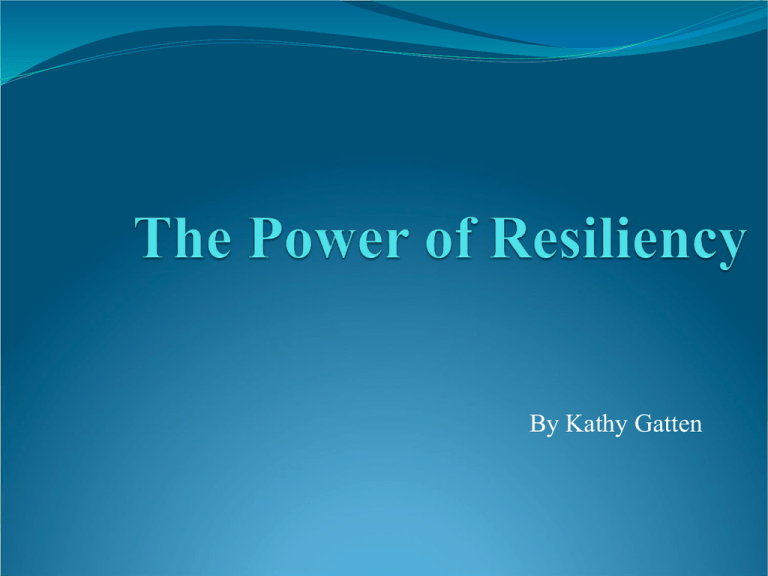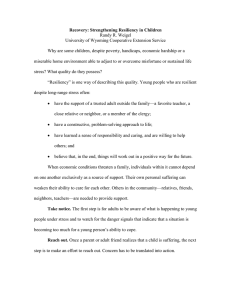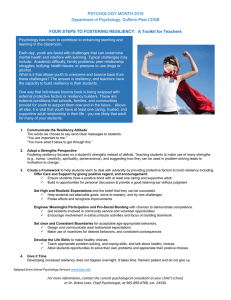By Kathy Gatten
advertisement

By Kathy Gatten Training Objectives Learn the concept and definitions of resiliency Examine why it is important to study resiliency as an educator Review a snapshot of risks students face Discuss current resiliency research Learn specific strategies to develop and support resiliency in your students Discussion: 1 How would you describe someone who is resilient? How do individuals develop resilient qualities? “The world breaks everyone and afterward many are strong at the broken places.” Ernest Hemingway Resiliency is Catching On Military: Army “…to not only bounce back, but to thrive under challenging conditions.” – Brigadier Cornum Business: IBM “The ability of an organization’s business operations to rapidly adapt and respond…” Resiliency Defined A pattern of positive adaptation in the context of past or present adversity (Wright & Masten, 2005). A set of inner resources, social competencies, and cultural strategies that permit individuals to not only survive, but recover, or even thrive after stressful events, but also to draw from the experience to enhance subsequent functioning (Stanton-Salazar & Spina, 2000). Resiliency Defined (cont.) Resilience in childhood is defined as typical development in the face of adverse circumstances that propel others to deleterious outcomes (Deater-Deckard, Ivy, & Smith, 2005). Resilience itself could be seen as the process of, capacity for, or outcome of successful adaptation in the face of challenging or threatening circumstances (Veselksa, Geckova, Orosova, Gajdosova, van Dijk, & Reijneveld, 2008). Why Study Resiliency? Children face adversity and are at risk Wide variety of outcomes Risks Students Face in CA Poverty A child is born into poverty every 5 minutes 1,591,295 children or 17.3% live in poverty (below $22,050 for a family of 4) 6.6% live in extreme poverty (below one-half of poverty dollar amount)…. increased to 8% in 2009 (http://datacenter.kidscount.org) Abuse A child is abused or neglected every 6 minutes Risks Students Face in CA Juvenile Arrests 231,735 arrests in 2008 15,240 living in juvenile residential facilities Firearms A child or teen is killed by gunfire every 20 hours Academic Challenges 77% of 4th graders are below grade level in reading 70% of 4th graders are below grade level in math 6.5% of 16 to 19 year olds are not enrolled in school and not high school graduates -Children’s Defense Fund (www.childrensdefense.org) Making a Difference… “Shifting the balance or tipping the scales from vulnerability to resilience may happen as a result of one person or one opportunity.” - F. Benard How Does Resiliency Work? How do children “make it”? Risks Protective Factors Assets Background of Resiliency Research Understand, prevent, and treat mental health problems Understand the etiology of mental illness, schizophrenia, and conditions such as autism Evaluate consequences of major threats to development such as premature birth or trauma In this process, researchers recognized unexpectedly positive adaptation or recovery after adversity in the lives of the young people they studied Resiliency Research Resiliency Theory First Wave: Identify the Characteristics Internal/External Qualities Development of 40 Developmental Assets (www.Search-Institute.org) Second Wave: Attain the Qualities Resiliency Model: Interaction between life prompts and protective factors Third Wave: Concept of Resilience Motivational energy Closer look at prevention and intervention Resiliency Research (cont.) Fourth Wave: Integrative Looks at genes and their role in resilience development Examines gene and environmental associations Developmental Assets (ages 12-18) External Assets Support: Family Support Positive Family Communication Other Adult Relationships Caring Neighborhood Caring School Climate Parent Involvement in Schooling Empowerment Community Values Youth Youth as Resources Service to Others Safety Discussion: 2 External Developmental Assets Which, if any, of these assets surprised you? Which of these assets would you like to focus more on developing in your students? What are some strategies you could begin to implement? Need suggestions? Go to: http://www.search-institute.org Developmental Assets (ages 12-18, cont.) External Assets Boundaries & Expectations Family Boundaries School Boundaries Neighborhood Boundaries Adult Role Models Positive Peer Influence High Expectations Constructive Use of Time Creative Activities Youth Programs Religious Community Time at Home Developmental Assets (ages 12-18, cont.) Internal Assets Commitment to Learning Achievement Motivation School Engagement Homework Bonding to School Reading for Pleasure Positive Values Caring Equality and Social Justice Integrity Honesty Responsibility Restraint Developmental Assets (ages 12-18, cont.) Internal Assets Social Competencies Planning and Decision Making Interpersonal Competence Cultural Competence Resistance Skills Peaceful Conflict Resolution Positive Identity Personal Power Self-esteem Sense of Purpose Positive View of Personal Future Discussion: 3 Internal Developmental Assets Which, if any, of these assets surprised you? Which of these assets would you like to focus more on developing in your students? What are some strategies you could begin to implement? Need suggestions? Go to: http://www.search-institute.org How Many Experience Each Asset? External Assets below 30% Positive Family Communication Caring School Climate Parent Involvement in Schooling Community Values Youth Youth as Resources Adult Role Model (27%) Creative Activities Internal Assets below 30% Reading for Pleasure Assets and High Risk Behaviors 70% 60% 50% 40% 0-10 Assets 11-20 Assets 21-30 Assets 31-40 Assets 30% 20% 10% 0% Problem Alcohol Use Violence Illicit Drug Use Sexual Activity Assets & Positive Attitudes/Behaviors 100% 90% 80% 70% 60% 0-10 Assets 11-20 Assets 21-30 Assets 31-40 Assets 50% 40% 30% 20% 10% 0% Exhibits Leadership Maintains Good Health Values Diversity Succeeds in School Does the presence of developmental assets affect standardized test performance? Safety at School & Annual Changes in SAT-9 Scores in Reading, Language & Math Change in SAT-9 (NPR) 2.5 2 1.5 Reading Language 1 Math 0.5 0 73 79 85 91 -0.5 Percent in school reporting feeling safe or very safe 97 School Caring Relationships & Annual Changes in SAT9 Scores in Reading, Language & Math 3 Change in SAT-9 (NPR) 2.5 2 Reading Language Math 1.5 1 0.5 0 52 58 64 71 77 -0.5 Percent in school reporting caring relations at school High School Expectations & Annual Changes in SAT-9 Scores in Reading, Language & Math 2.5 Change in SAT-9 (NPR) 2 1.5 Reading Language Math 1 0.5 0 58 65 72 80 87 -0.5 -1 Percent in school reporting high expectations at school Community Meaningful Participation & Annual Changes in SAT-9 Scores in Reading, Language & Math 3 Change in SAT-9 (NPR) 2.5 2 1.5 Reading Language Math 1 0.5 0 48 55 62 70 77 -0.5 -1 Percent in school reporting meaningful participation in community Sadness/Hopelessness & Annual Changes in SAT-9 Scores in Reading, Language & Math 3 Change in SAT-9 (NPR) 2.5 2 Reading Language Math 1.5 1 0.5 0 20 25 29 34 39 -0.5 Percent in school reporting sadness/hopelessness Resiliency Research Resiliency Theory First Wave: Identify the Characteristics Internal/External Qualities Development of 40 Developmental Assets Second Wave: Attain the Qualities Resiliency Model: Interaction between life prompts and protective factors Third Wave: Concept of Resilience Motivational energy Still opposing views Resiliency Model Reintegration with Resiliency Stressors Adversity Risks Reintegration to Comfort Zone (Homeostasis) Individual & Environmental Protective Factors Reintegration with Loss (Maladaptation) Disruption Reintegration Dysfunctional Reintegration Adapted from Richardson, Neiger, Jensen & Kumpfer, 1990 Key Points in Resiliency Model When individuals experience adversity, they also experience protective factors These internal and external protective factors buffer the effects of adversity Without protective factors, some individuals experience maladaptive coping mechanisms such as substance abuse, loss of self-worth, or an increase in risky behaviors Resiliency Model Messages Adversity can lead to a variety of outcomes Both internal and external factors in the environment are critical for building resiliency Resiliency Model in Schools Provide Opportunities for Meaningful Participation Build Resiliency in the Environment Set and Communicate High Expectations Provide Caring & Support Increase Prosocial Bonding Set Clear, Consistent Boundaries Mitigate Risk Factors in the Environment Teach Life Skills Henderson & Milstein, 1996 Discussion: 4 Mitigate/Lesson Risk Factors in the Environment Increase Pro-Social Bonding What are some ways you can increase and support connections between students and persons or activities? Fostering Resiliency with Students Provide Opportunities for Meaningful Participation Set and Communicate High Expectations Provide Caring & Support Increase ProSocial Bonding Set Clear, Consistent Boundaries Teach Life Skills Keep and encourage family members to be involved. Communicate regularly with family members regarding positive behaviors/academic performance. Consciously care and connect with students regularly and positively Support students to be involved with some of the many before, after, and inschool activities Fostering Resiliency with Students Provide Opportunities for Meaningful Participation Set and Communicate High Expectations Provide Caring & Support Increase ProSocial Bonding Set Clear, Consistent Boundaries Teach Life Skills Provide opportunities for cooperative peer-to peer interactions through teaching strategies and/or school programs Promote sharing of responsibilities, service to others, required helpfulness Discussion: 5 Mitigate/Lesson Risk Factors in the Environment Set Clear, Consistent Boundaries What are some examples of how you can effectively set boundaries/rules in the classroom? Fostering Resiliency with Students Provide Opportunities for Meaningful Participation Set and Communicate High Expectations Provide Caring & Support Increase ProSocial Bonding Set Clear, Consistent Boundaries Teach Life Skills Norms, rules, and policies are communicated clearly and regularly Involve students in rule setting and consequences as appropriate Discussion: 6 Mitigate/Lesson Risk Factors in the Environment Teach Life Skills What are some life skills you value as important to model for your students or include in your curriculum development? Fostering Resiliency with Students Provide Opportunities for Meaningful Participation Set and Communicate High Expectations Provide Caring & Support Increase ProSocial Bonding Set Clear, Consistent Boundaries Teach Life Skills Provide ongoing instruction in life skills appropriate to developmental tasks such as goal setting, identifying and expressing positive and negative feelings Integrate and support the following skills: assertiveness, healthy conflict resolution, cooperation, good decision making and effective problem solving Model and discuss healthy stress management techniques Discussion: 7 Build Resiliency in the Environment Provide Caring and Support What are some ways you can demonstrate caring and support toward your students? Fostering Resiliency with Students Provide Opportunities for Meaningful Participation Set and Communicate High Expectations Provide Caring & Support Provide unconditional positive regard and encouragement Increase ProSocial Bonding Set Clear, Consistent Boundaries Teach Life Skills Notice all students, draw out those who may not readily participate, and intervene when necessary Remark on strengths and coping mechanisms Provide a variety of ways for students to be recognized and rewarded Reward random acts of kindness Discussion: 8 Build Resiliency in the Environment Set and Communicate High Expectations What do you say or do that communicates your high expectations to your students? Fostering Resiliency with Students Develop cooperative teaching strategies Provide Opportunities for Meaningful Participation Set and Communicate High Expectations Provide Caring & Support Increase ProSocial Bonding Set Clear, Consistent Boundaries Teach Life Skills Focus on both extrinsic and intrinsic motivation based on age and interest Place responsibility for learning on the students through active participation Communicate that the schoolwork is important, you are confident it can be done, and you will not give up on them. Discussion: 9 Build Resiliency in the Environment Provide Opportunities for Meaningful Participation What are some strategies you use to encourage and increase participation with your students? Fostering Resiliency with Students Provide Opportunities for Meaningful Participation Set and Communicate High Expectations Provide Caring & Support Allow and encourage students to participate in class or school decisions.. Increase ProSocial Bonding Set Clear, Consistent Boundaries Teach Life Skills Provide opportunities to help other students through cooperative learning, peer helping or providing service to others. Support students in taking on new challenges in and outside of the classroom. Resiliency Research Resiliency Theory First Wave: Identify the Characteristics Internal/External Qualities Development of 40 Developmental Assets Second Wave: Attain the Qualities Resiliency Model: Interaction between life prompts and protective factors Third Wave: Concept of Resilience Motivational energy Still opposing views rd 3 Wave: Concept of Resilience Motivational Energy Required What triggers resilience: sources of strength Other Areas Considered Promotion of interventions such as protective processes Focus on promoting competence and wellness th 4 Wave: Integrative Approach Assimilate older work: using new technology and integrative studies across multiple levels of analysis Define positive adaptation at cellular or neural levels Look at gene-environment interactions and how they influence adaptive behavior Considers the many other additional systems involved in resilience beyond the individual and the immediate environment such as ecosystems, computer, communication, health care, and political systems. Prominent Research Studies Longitudinal Study in Kauai (Werner, 1995 & 1996) 698 individuals born in 1955, followed through age 32 1/3 high risk (poverty, perinatal stress, family discord, divorce, parental alcoholism, or mental illness) 2/3 developed serious learning or behavior problems by age 10 or delinquency records, mental health problems or pregnancies by age 18. 1/3 competent adults (who had experienced 4 or more risk factors) Kauai (cont.) Protective Factors within the Individual Infancy and Early Childhood Temperaments that elicit positive responses: active, affectionate, cuddly, good-natured Developed coping patterns: autonomy and ability to ask for help Middle Childhood and Adolescence Good problem solving and communication skills Not gifted, but used talents effectively Figure out strategies for coping with adversity, either through their own efforts or reaching out to others for help Kauai (cont.) Protective Factors within the Individual (cont.) Adulthood Sought compatible environments: school, work, military Found own “niche” Kauai (cont.) Protective Factors within the Family Close bond with one person—grandparents or siblings Held religious beliefs that provided stability and meaning Boys: household with structure and rules; encouragement of emotional expressiveness Girls: emphasis on risk taking and independence; reliable support from female caregiver Kauai (cont.) Protective Factors Within the Community Rely on peers and elders for emotional support Seek out others for counsel and comfort in times of crisis Teachers played a critical role All resilient high-risk children in this study could point to at least one teacher who was an important source of support Teachers listened, challenged, and rooted for them Summary of Kauai Findings Clusters of protective factors—internal and external Individual Temperament Skills and Values Sought out Emotional Support Supportive Adults One Teacher Choose Compatible Life Opportunities Research Studies (cont.) Longitudinal Study in Chicago 1539 individuals born around 1940, followed through age 24; low income, minority children Key Result Educational attainment prevents unwanted health outcomes (reduces smoking, substance abuse, depression) Project Competence 205 individuals, 3rd-6th grades, followed over 10 years Key Result If reasonable good resources are present, competence outcomes are generally good, even in the context of severe stressors Research Studies (cont.) Isle of Wight 571 individuals, ages 9 and 10 in 1964; followed through adolescence Prevalence and pattern of handicaps during the last 50 years with marked changes in social and material conditions Isle of Wight (follow-up study, child abuse, 1998-2000) 378 of original group, ages 42-46 Key Results Good quality relationships across childhood, adolescence, and adulthood important for well-being Factors for resiliency included having one caring parent, positive peer relationships, stability of adult love relationships Positive attachment throughout life support resilience Additional Findings Foster Children Academically successful (education beyond high school) possessed several internal and external protective factors; involved in community service (Hass & Graydon, 2009) Youth Offenders Internal and external protective factors decreases recidivism (Carr & Vandiver, 2001) The Resiliency Quiz Let’s check our own level of resiliency… Relationships “When powerful relationships are established between teachers and students, these relationships frequently can transcend the economic and social disadvantages that afflict communities and schools alike in inner city and rural areas.” -Cummins, 1996 Power of Relationships “Resilience rests, fundamentally, on relationships.” -Luthar, 2006 “The importance of relationships for human resilience has been noted in every major review of resilience…” -Masten & Obradovie, 2008 “It is obvious that children will work harder and do things--even odd things like adding fractions---for people they love and trust.” -Noddings, 1988 Promoting Resiliency in Schools Classroom Interventions Practice empathy Help all students feel welcome and appreciated Develop realistic expectations Discuss the role of mistakes in learning Develop responsibility and compassion Teach students how to solve problems and make decisions Use discipline to promote self-discipline -Brooks & Goldstein (2001) Resources for Teachers Websites www.search-institute.org www.cdl.org Free Newsletters from the Search Institute YouthSense: a resource for people who work with children and teens The Asset Champion: inspiring stories from community initiatives around the world Insights and Evidence: latest research findings Resources for Teachers (cont.) Books “Fostering Resilience,” by Martin Krovetz “Resiliency: What we Have Learned,” by Bonnie Bernard “Understanding and Managing Children’s Classroom Behavior”, by Sam Goldstein and Robert Brooks Resources for Parents Websites www.raisingresilientkids.com www.search-institute.org www.dosomething.org Books “Raising Resilient Children: Fostering Strength, Hope and Optimism in Your Child” by Robert Brooks and Sam Goldstein. Any Questions? The End


